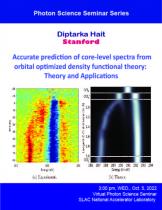SLAC, Hybrid Photon Science Seminar / B053-2002 Berryessa Conference Room / Zoom Link https://stanford.zoom.us/j/95714511566?pwd=QllFSjYzc3dXS3FBNkZYL294TXF2UT09
Speaker: Diptarka Hait, Stanford
Program Description:
Density functional theory (DFT) is widely used to model the electronic structure of chemical systems, as it is perceived to offer a good balance between predictive accuracy and computational cost. The popular time-dependent DFT (TDDFT) approach for modeling excited states is however not well suited for describing core-level spectra, as it cannot model the relaxation of the core hole. Consequently, TDDFT errors are ~ 10 eV for the carbon K-edge and becomes much larger for heavier elements.
We have developed a technique to model core-hole relaxation within DFT, by explicitly optimizing the excited state orbitals. This approach has the same computational scaling as ground state DFT and is reliable at converging to the desired excited state. This orbital optimized DFT (OO-DFT) technique predicts core-level excitation energies with ~0.3 eV RMS error for both closed- and open-shell systems.
I will briefly present the background and theory behind our OO-DFT approach and describe how it was validated against previous experimental data. I will then discuss some collaborative work with the Leone group at Berkeley, in which transient X-ray absorption experiments and OO-DFT calculations were simultaneously employed to study chemical dynamics. In particular, I will focus on the Jahn-Teller distortion and bond dissociation dynamics of CCl4+, which was studied at the carbon K and chlorine L edges with femtosecond resolution.
Email: diptarka@stanford.edu
Co-authors: Andrew D. Ross, Stephen R. Leone, Martin Head-Gordon.





